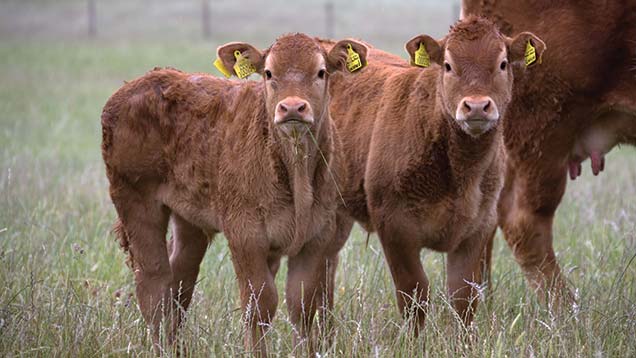Creep-feed beef calves now for best return on investment
 © Tim Scrivener
© Tim Scrivener Suckler producers considering creep-feeding calves should do it now rather than wait until weaning to take advantage of good feed conversion rates.
Speaking to Farmers Weekly at the Royal Welsh Show, Lachlan Maclachlan, beef and sheep specialist at Mole Valley Farmers, estimated nearly one-quarter of farmers wait until weaning to creep-feed calves.
But he warned it was far more efficient to creep calves at a younger age.
See also: More news from the Royal Welsh Show
“At about 350-400kg the feed conversion ratio is about 4:1. It is the most efficient period of an animal’s life. By the time they are 500kg their feed conversion falls to about 8:1.”
He said the risk with leaving it until weaning was that you could get a months’ check in growth as a result of calves adjusting to big diet changes at the same time as coping with the stress of leaving their dams.
He said many farmers don’t creep-feed calves at grass because they see it as a chore.
“It is another job and they have to buy a calf feeder.”
But rather than looking at it as a cost, he urged farmers to look at it as an investment.
Mr Maclachlan said creep-feeding could add an additional 40kg liveweight at weaning. Even at £1/kg after feeding he said this could equate to £40.
“If a creep-feed costs £1,000 and you have 50 suckler cows and 45 calves, and creep feeding is worth £40 an animal after feed, that is the equivalent of £1,800 – so you will more than pay for it in a year.”
Mr Maclachlan said calves should be creep-fed by the age of three months at the latest.
“[By then] the cow has produced three months’ milk and the calf is starting to look for other nutrients to maintain its growth.”
Creep feeding at grass will also maintain a cow’s condition score by taking the pressure off milk production, he added.
Mr Maclachlan said growing cattle require 20% starch creep.
“The reason for not putting any more than that in [the diet] is the calf will be putting on too much condition and will get too fat.”
He also highlighted the importance of weighing cattle at least once a month to ensure they are meeting growth targets of at least 1kg/day.
Supplementary feeding stock
Independent grassland expert Gareth Davies said although it was important to consider the cost benefit of creep-feeding earlier, farmers shouldn’t underestimate the gains that can be achieved from good-quality grass.
“When cattle have a plentiful supply of grass they will pile on the weight providing it is good quality.”
He advised farmers to take grass samples to see if the quality was in decline before they decided to supplementary feed animals.
He said grass samples should be taken at least four times a year; early in March, again in May and then in July and mid-September.
“You will struggle to put weight on animals if the ME is below 10.5,” he added.
Mr Davies said at the end of the summer you get “autumn balance” whereby demand outstrips supply as growth slows, so it is also important to measure quantity available to make sure stock is getting enough.
“It will also depend on your grass growth and your stocking rate, so it is important to measure grass and work out if you have a feed deficit.”
How to work out grass demand |
|
|
Stock |
60 growing cattle @300kg |
|
Demand |
3% of bodyweight (300kg x 0.03 = 9kg/head/day) |
|
Group demand |
540kg/dm/day (9 x 50) |
|
Amount of grass in field/ha |
2,500kg DM |
|
Target residual/ha |
1,500kg DM |
|
Average feed/ha |
1,000kg DM |
|
Grass growth |
20kg DM/ha/day |
|
Field size |
1ha |
|
Time in field |
2 |
|
Grass deficit/ha |
120kg DM |
|
Field x will be grazed by 60 growing cattle for two days and will require 1080kg DM [540kg DM/day x 2] over that period. Without grass growth, the sward would be reduced to 1420kg DM/ha (2,500-1,080) which is lower than the target residual. However, with grass growing at 20kg DM/ha per day during those two days, the target residual will be nearly met [2,500kg DM/ha – 1,080kg DM/ha + 40kg DM/ha = 1,460kg DM/ha]. The deficit is just 40kg DM/ha (1500 -1,460) |
|
